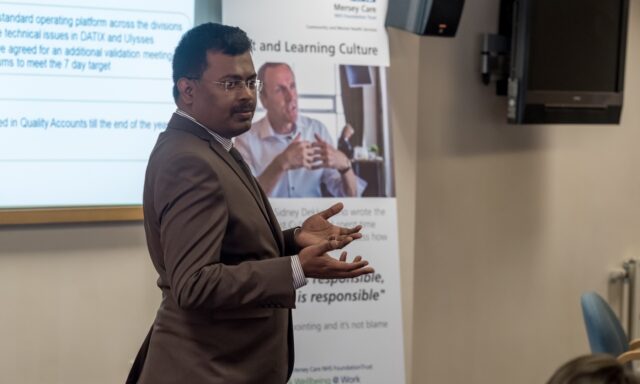
The work of a Second Opinion Appointed Doctor (SOAD) sits quietly but vitally within the framework of the Mental Health Act. It is a role designed to bring independent medical scrutiny into some of the most serious decisions taken in mental health care: whether patients detained under the Act should receive particular care without their consent.
The responsibility is both clinical and legal. SOADs are asked to provide an impartial second opinion on whether a proposed treatment is appropriate, lawful and in the best interests of the patient. Their oversight helps safeguard rights, protect patients and give clinicians confidence that decisions stand on solid ground.
For Pearl Hettiaratchy, this has been a professional focus of hers for more than four decades. Now in her 80s, she remains a practising SOAD and continues to adapt her work to new contexts and technologies. Her reflections, shared with Thalamos, offer a unique view of how the role has evolved since the 1980s, how it operates today and what it may look like in the years ahead.
The early years of the SOAD role
Hettiaratchy recalled that when she began working as a SOAD, at the time alongside being a Mental Health Trust consultant and serving on the General Medical Council, Tribunals and other health-related bodies, the role was less formally structured and far more reliant on paper and postal systems. The function itself was relatively new, created under the Mental Health Act 1983 to ensure patients detained for treatment had an added layer of independent oversight. At that time, she said, SOADs would receive paper forms by post or by phone, travel to clinical locations to examine patients and meet staff, and then return paperwork manually to the regulator.
Much of the work was logistically slow. Hettiaratchy remembered how the process could involve long waits, with papers going missing or administrative delays. Despite these difficulties, the principle of the role was clear: a SOAD needed to bring independence, impartiality and fairness to decisions that had life-changing implications for patients.
How the role has changed
In the decades since, Hettiaratchy has seen the role grow in importance as mental health law has become more detailed and patient rights have been more carefully defined. She described how expectations on SOADs have widened, with greater emphasis on documenting reasons, recording evidence and ensuring patients are given every possible opportunity to participate in decisions.
She observed that the clinical landscape has shifted significantly. When she began, the range of treatments under consideration was narrower. Today, SOADs are asked to consider more complex medication regimes, therapies and combinations, alongside an increased awareness of side effects and long-term impacts.
Hettiaratchy highlighted that scrutiny has become deeper and more structured. Where once the role was about providing reassurance to clinicians and the regulator, it is now about evidencing a thorough, balanced and defensible process. That shift has increased the weight of responsibility but also reinforced the value of the role as a safeguard.
Challenges facing SOADs today
Hettiaratchy was candid about the pressures currently facing the SOAD landscape. She described mounting pressures specific to the SOAD system, which reflect wider pressures to the mental health system, noting a backlog of patients waiting to be seen and said the workload falls on a relatively small group of active SOADs. From her perspective, there are around 40 or so very active SOADs shouldering the majority of the work, with many others completing only a small number of cases each year.
She placed herself in the 200 to 300 cases a year range and noted that some colleagues undertake close to 500. She explained that Tribunals work generally pays more, which naturally draws some doctors away from second opinion work — particularly those earlier in their careers who need to balance commitments. Then there is the issue that fees do not always reflect the complexity of cases such as when medication and ECT decisions are combined into a single review, even though each can take several hours to complete.
Delays are also compounded by administrative pinch points. Trust teams, often due to their own operational pressures, can be slow to provide the information SOADs need to complete assessments. Other frustrations include not being able to amend certificates once local scrutiny has taken place, and the absence of routine feedback or structured audit. Hettiaratchy felt these factors together contribute to delays and can discourage participation.
Yet she believes this context only underlines the importance of the SOAD role. Patients detained under the Act are in uniquely vulnerable circumstances. They may be unable or unwilling to consent to certain care, yet their rights and dignity must still be protected. Having an independent doctor step in to review decisions is a way of keeping the system accountable, ensuring treatment is both lawful and clinically justified. It’s also important to emphasise the collective intelligence SOADs develop through this work, offering a valuable, real-time view of emerging trends and challenges across the mental health system.
The importance of scrutiny
Throughout her reflections, Hettiaratchy emphasised that scrutiny is at the heart of what SOADs do. She described the role as a safeguard for patients, a reassurance for families and an anchor for clinicians. By independently reviewing proposed treatments, SOADs give weight to the principle that decisions must be justifiable, balanced and proportionate.
Hettiaratchy noted that this scrutiny is not adversarial. SOADs are not there to challenge clinicians for the sake of it, but to stand alongside them in ensuring that the care being delivered is appropriate. That requires careful listening, gathering evidence from multiple sources, seeing patients directly or through video call platforms and forming an independent clinical judgement. The result, she said, is a decision that carries authority precisely because it has been tested.
Digitisation and the Covid era
The arrival of Covid changed the practicalities of the SOAD role almost overnight. Hettiaratchy recalled how it suddenly became unsafe or impossible to travel to hospitals, meet patients face to face and handle paper forms. The system had to adapt quickly. Remote consultations, electronic forms and digital communication became essential to keep the process running.
This period accelerated digitisation. For Hettiaratchy, moving onto platforms like eMHA by Thalamos has made a dramatic difference. She spoke about how paperwork is now far more reliable, forms are easier to access and the risk of documents going astray has been removed. What was once dependent on postal systems can now be handled securely online.
Digitisation has also created new efficiencies. Hettiaratchy observed that information can be shared more quickly between SOADs, hospitals and the regulator. That in turn reduces delays for patients and lessens administrative burdens on clinicians. While she values the in-person aspects of the role, she recognises that digital systems have made the process stronger and more resilient.
Embracing change in her 80s
What stands out from Hettiaratchy’s reflections is her openness to change. Despite being in her 80s, she continues to embrace new systems and sees digital tools as an improvement rather than a barrier. She spoke about how eMHA by Thalamos has removed frustrations that had persisted for years and how the move to electronic systems has given the role a new level of reliability.
For Hettiaratchy, this willingness to adapt is part of what makes the SOAD role enduring. The principle of independent scrutiny remains constant, but the methods evolve with time. She is clear that embracing digitisation is essential to ensure the role continues to deliver for patients.
Looking to the future
Asked about the future of the SOAD role, Hettiaratchy reflected that the need for independent oversight will not diminish. If anything, she believes it will become more important as care evolves and services continue to face pressures. She anticipates that digital systems will become even more central, perhaps enabling more data-driven oversight and wider sharing of best practice.
Yet at its core, she believes the role will remain about patients. Meeting them, listening to them and making sure their voices are heard will always be essential. No technology can replace that human element, but it can support SOADs to deliver it more effectively.
Celebrating the role
Hettiaratchy’s long career as a SOAD is a reminder of the dedication and resilience that underpin mental health crisis care. For forty years she has provided a service that often goes unnoticed but makes a profound difference for patients. Her continued commitment in her 80s shows not only the importance of the role but also the value of experience and adaptability.
The SOAD role exists to protect rights, uphold fairness and strengthen trust in the mental health system. Hettiaratchy’s story illustrates how it has evolved, how it continues to face challenges and how it is adapting to a digital age. As part of a new series shining a light on key roles in crisis care, it stands as a testament to the vital contribution made by those who dedicate their careers to safeguarding patients.
If you’ve enjoyed this article then make sure you are subscribed to our newsletter for future focus articles on key roles in crisis care.


